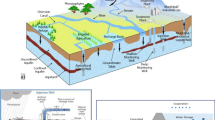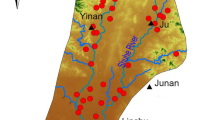Abstract
As groundwater is a vital water resource and plays an important role in sustainable use and environment maintenance, evaluating the groundwater flow is crucial. To quantitatively ascertain the groundwater flow at the Echi-gawa alluvial fan, Japan, groundwater budget was carried out by combining hydrogeological parameters (hydraulic gradient, hydraulic conductivity, and recharge rate) and modified aquifer structures (unconfined/confined aquifers and aquitards). The groundwater budget was calculated on the right bank (B–B′ cross section) and left bank (C–C′ cross section) of the Echi River, where the aquifer structures are significantly different. The total flow rate in the unconfined aquifer was 533.2 × 103 m3/year, of which the outflow to the confined aquifer was 14% in B–B′, whereas the total flow rate in the unconfined aquifer was 433.7 × 103 m3/year, of which the outflow to the confined aquifer was 2.7% in C–C′. The difference of the outflow to the confined aquifer between B–B′ and C–C′ is derived from the difference of the updated aquifer structures. The groundwater budget indicated that 5–20-holds amount of the groundwater infiltrates to more deeper aquifers than the aquitard the study targeted near the foot of mountains. The groundwater pumping in the confined aquifer in B–B′ affects the infiltration of the unconfined aquifer, which may control the groundwater quality. Results of the groundwater budget in this study are well corresponded to the previous studies. Although separating the groundwater pumping and the upward groundwater flow rate using the groundwater budget this study provided is unavailable due to lack of the hydraulic head in ATI in C–C′, the method used for this study is adequate to reproduce groundwater flow systems, which may be applicable to areas, where the aquifer structures are unestablished.






Similar content being viewed by others
References
Alattar MH, Troy TJ, Russo TA, Boyce SE (2020) Modeling the surface water and groundwater budgets of the US using MODFLOW-OWHM. Adv Water Resour 143:103682. https://doi.org/10.1016/j.advwatres.2020.103682
Alley WM, Leake SA (2004) The journey from safe yield to sustainability. Groundwater 42(1):12–16
Barackman M, Brusseau ML (2002) Groundwater sampling. In: Artiola JF, Pepper IL, Brusseau ML (eds) Environmental monitoring and characterization. Academic Press, Burlington, pp 121–139
Cervi F, Tazioli A (2021) Quantifying streambed dispersion in an alluvial fan facing the northern Italian Apennines: implications for groundwater management of vulnerable aquifers. Hydrology 8(3):118. https://doi.org/10.3390/hydrology8030118
Demiroglu M (2019) Groundwater budget rationale, time, and regional flow: a case study in Istanbul, Turkey. Environ Earth Sci 78:682. https://doi.org/10.1007/s12665-019-8713-2
Earle S (2019) Physical geology, 2nd edn. BCcampus, Victoria. Retrieved from https://opentextbc.ca/physicalgeology2ed/. Accessed 28 Dec 2021
England LA, Freeze RA (1988) Finite-element simulation of long-term transient regional groundwater flow. Groundwater 26:298–308
Genereux DP, Jordan MT, Carbonell D (2005) A paired-watershed budget study to quantify interbasin groundwater flow in a lowland rain forest, Costa Rica. Water Resour Res 41:1–17
Gu XM, Shao JL, Cui YL, Hao QC (2017) Calibration of two-dimensional variably saturated numerical model for groundwater flow in arid inland basin, China. Curr Sci 113:403–412
Hamada T, Yamada M, Ao L, Horiuchi K, Yang H, Kobayashi M, Nonomura O (2008) Groundwater flow system in alluvial fan of Echi-gawa traced by groundwater potential, water quality and isotopic compositions. In: Hydro-environments of Alluvial Fans in Japan, Research group on hydro-environment around alluvial fans, Toyama, pp 211–222 (in Japanese)
Harayama S, Miyamura M, Yoshida F, Miura K, Kurimoto C (1989) Geology of the Gozaishoyama district, with geological sheet map at 1:50,000. Geol Surv Jpn 30:1–145 (in Japanese)
He B, Takase K, Wang Y (2008) Numerical simulation of groundwater flow for a coastal plain in Japan: data collection and model calibration. Environ Geol 55:1745–1753
Hijii T, Kayaki T, Watanabe O, Oishi A, Hamada T, Kobayashi M (2008) Water budget of the Echi-gawa alluvial fan-simulation results-. In: Hydro-environments of Alluvial Fans in Japan, Research group on hydro-environment around alluvial fans, Toyama, pp 191–210
Horino H, Watanabe S, Maruyama T (1989) Study of an actual demonstrations on the role of groundwater in agriculture water utilization. Pap Ser Agric Eng 144:9–16 (in Japanese)
Ibrakhimov M, Awan UK, George B, Liaqat UW (2018) Understanding surface water–groundwater interactions for managing large irrigation schemes in the multi-country Fergana valley, Central Asia. Agric Water Manag 201:99–106
Ikeda H, Ohashi T, Uemura Y, Yoshikoshi A (1979) Geomorphology of the Ohmi Basin. In: Land and Life in Shiga-Seperate Volume for Geomorphology and Geology and Geologic Map of Shiga Prefecture 1:100,000 in Scale. Shiga Prefecture Nature Conservation Foundation, Japan, pp 1–112 (in Japanese)
Japanese Geotechnical Society (2005) Ground survey-Basic and Guidance. Maruzen Publishing, Tokyo (in Japanese)
Kobayashi M, Hijii T, Yang H, Hamada T (2008) Relations between groundwater and river water in the Echi-gawa alluvial fan. In: Hydro-environments of Alluvial Fans in Japan, Research group on hydro-environment around alluvial fans, Toyama, pp 223–234
Kobayashi M, Yamada M, Yang H, Hijii T (2010) Study of the groundwater flow system in the Echi-gawa alluvial fan, Shiga Prefecture, Japan. In: Taniguchi M and Holman IP (eds) Groundwater response to changing climate. Taylor & Francis Group, London, UK, pp 179–195
Lu CY, Hu JC, Chan YC, Su YF, Chang CH (2020) The relationship between surface displacement and groundwater level change and its hydrogeological implications in an alluvial fan: case study of the Choshui River, Taiwan. Remote Sens 12(20):3315. https://doi.org/10.3390/rs12203315
Nishimura S (1979) Gravity survey in Shiga Prefecture. In: Land and Life in Shiga-Seperate Volume for Geomorphology and Geology and Geologic Map of Shiga Prefecture 1:100,000 in Scale. Shiga Prefecture Nature Conservation Foundation, Japan, pp 469–478 (in Japanese)
Oishi A, Kobayashi M, Hamada T, Okuda E, Miyazaki S, Hu S (2008) Hydrogeology on Echi-gawa alluvial fan, Shiga Prefecture, Central Japan. In: Hydro-environments of Alluvial Fans in Japan, Research group on hydro-environment around alluvial fans, Toyama, pp 191–210
Sakata Y, Baran G, Suzuki T, Chikita A (2016) Estimate of river seepage by conditioning downward groundwater flow in the Toyohira River alluvial fan, Japan. Hydrol Sci J 61:1280–1290. https://doi.org/10.1080/02626667.2015.1125481
Sakura Y (1984) Groundwater investigation using temperature. J Groundw Hydrol 26:193–197
Shimada J, Ito S, Arakawa Y, Tada K, Mori K, Nakano K, Kagabu M, Matsunaga M (2015) Nitrate budget in the shallow unconfined groundwater of double cropped paddy area considering chemical fertilizer input—results of 3D groundwater flow simulation with observed water chemistry data. J Groundw Hydrol 57(4):467–482. https://doi.org/10.5917/jagh.57.467 (in Japanese)
Takase K, Fujihara Y (2019) Evaluation of the effects of irrigation water on groundwater budget by a hydrologic model. Paddy Water Environ 17:439–446
Thornthwaite CW (1948) An approach toward a rational classification of climate. Geogr Rev 38:55–94
Tóth J, Hayashi M (2010) The theory of basinal gravity flow groundwater and its impacts on hydrology in Japan. J Groundw Hydrol 52:335–354
Tóth J, Millar RF (1983) Possible effects of erosional changes of the topographic relief on pore pressure at depth. Water Resour Res 19:1585–1597
Viaroli S, Mastrorillo L, Lotti F, Paolucci V, Mazza R (2018) The groundwater budget: a tool for preliminary estimation of the hydraulic connection between neighboring aquifers. J Hydrol 556:72–86
Xiao Y, Hao Q, Zhang Y, Zhu Y, Yin S, Qin L, Li X (2022) Investigating sources, driving forces and potential health risks of nitrate and fluoride in groundwater of a typical alluvial fan plain. Sci Total Environ. https://doi.org/10.1016/j.scitotenv.2021.149909
Yamamoto S (1983) Method of the groundwater survey. Kokon Shoin, Tokyo (in Japanese)
Yamanaka M, Sakamoto K (2016) Hydrogeochemical controls of groundwater in the Ohmama Alluvial Fan in Gunma Prefecture. J Groundw Hydrol 58(2):165–181 (in Japanese)
Yang H, Mitamura M (2012) Evaluation of the aquifer structure and the groundwater flow in the Echigawa alluvial fan area, Shiga Prefecture, Japan. J Geosci Osaka City Univ 55:1–10
Yang H, Kobayashi M, Mitamura M (2011) Groundwater flow and formation of groundwater temperature in the Echi-gawa Alluvial Fan, Shiga Prefecture, Japan. J Groundw Hydrol 53(2):165–177. https://doi.org/10.5917/jagh.53.165 (in Japanese)
Yin S, Xiao Y, Gu X et al (2019) Geostatistical analysis of hydrochemical variations and nitrate pollution causes of groundwater in an alluvial fan plain. Acta Geophys 67:1191–1203. https://doi.org/10.1007/s11600-019-00302-5
Yokoyama T, Matsuoka C, Tamura M, Amemori K (1979) On the Plio-Pleistocene Kobiwako Group, land of life in Shiga, pp 309–389 (in Japanese)
Zhou Y (2009) A critical review of groundwater budget myth, safe yield and sustainability. J Hydrol 370:207–213
Author information
Authors and Affiliations
Corresponding author
Ethics declarations
Conflict of interest
There are no conflicts of interest to declare.
Additional information
Publisher's Note
Springer Nature remains neutral with regard to jurisdictional claims in published maps and institutional affiliations.
Supplementary Information
Below is the link to the electronic supplementary material.
Rights and permissions
About this article
Cite this article
Yang, H. Groundwater flow evaluation using a groundwater budget model and updated aquifer structures at an alluvial fan of Echi-gawa, Japan. Model. Earth Syst. Environ. 8, 4359–4371 (2022). https://doi.org/10.1007/s40808-022-01394-7
Received:
Accepted:
Published:
Issue Date:
DOI: https://doi.org/10.1007/s40808-022-01394-7




